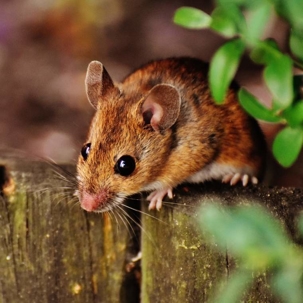What Attracts Mice?
Mice are small, quick, adaptable, and opportunistic. These rodents don’t need much space or food to survive, will exploit tiny openings, and prefer areas that provide warmth, cover and easy food access, but they will move into any home or business that reliably supplies their basic needs: food and shelter. If your property supplies consistent food, or sheltered nesting sites — even intermittently — it becomes attractive to mice. Here are some of the most common attractants:
Adjacent Infested Properties
Mice are excellent travelers; if neighboring homes, warehouses, restaurants, or dumpsters have infestations, your property becomes a convenient next stop.
Shared walls in apartment buildings or connected structures make it easy for mice to migrate.
Landscaping Choices
Thick groundcover, dense shrubs, hedges, ivy, or mulch placed right up against walls can provide shelter and cover for mice.
Trees or vines that touch the building create a “mouse highway” from the yard to your structure.
Bird feeders or pet feeding stations outside can unintentionally attract mice.
Lighting and Human Activity Patterns
Mice are nocturnal and prefer areas with minimal disturbance. Buildings that are dark, quiet at night, or poorly lit exterior areas are more attractive.
Businesses with extended hours or shift work may inadvertently provide food or water in low-traffic areas, encouraging mouse activity after hours.
Construction, Renovation, or Maintenance Work
Disturbing the soil, insulation, or walls can displace mice from their outdoor habitats, prompting them to move indoors.
Temporary storage of materials (wood, insulation, drywall) near a building can create a bridge for mice to enter.
Warmth
Mice are drawn to warm areas, especially in colder months.
Heating ducts, boiler rooms, near hot water tanks, and areas around warm machinery are especially attractive.
Businesses with refrigeration units or industrial equipment may provide a heat gradient that draws mice in during cold weather.
Easy Entry and Travel Routes
Gaps around utility lines, vents, doors, windows, foundation cracks, roofline openings, and damaged siding. Mice can squeeze through holes the size of a dime.
Unsealed garage doors, open loading bay doors, broken screens, or deteriorated mortar.
Overhanging tree branches, vines or connected roofs that allow mice to access the structure without touching the ground.
Readily Available Food
Unsealed pantry items (grains, cereals, pet food).
Food left out on counters, spills in kitchens or break rooms.
Open garbage cans, poorly sealed dumpster lids, or overflowing waste areas.
Food storage in cardboard boxes — easy to gnaw and nest in.
Bird seed, pet food bowls left outdoors, and compost piles.
Food debris in restaurant equipment, behind ovens, inside shelving, in storage rooms and loading docks.
Odors and Food Scents
Even minor food residues, grease, or cooking smells can attract mice. They have an extremely sensitive sense of smell.
Outdoor food odors, such as garbage or compost piles, nearby restaurants, or even neighborhood barbecues, can draw mice toward a property.
Stored grains, flour, or pet food with a lingering scent can be detected through walls and doors.
Improper Waste Storage
Recycling bins with paper, cardboard, or food containers that are not tightly secured.
Trash left overnight or accessible to rodents provides both food and nesting material.
Dumpster enclosures that are not rodent-proof allow mice to feed and breed nearby.
Clutter and Hiding Places
Even without food or water, cluttered spaces allow mice to feel safe from predators.
Piles of cardboard, old furniture, cardboard boxes, unused machinery, and fabric piles can all serve as nesting sites.
In offices or commercial properties, storage rooms, unused meeting rooms, and behind shelves provide perfect hiding spots.
Anything that provides food, warmth, shelter, or a pathway can attract mice. Some attractants are indirect — you might not see the food, water, or shelter directly, but environmental factors like warm areas, clutter, or neighbors’ waste can still draw them in.

